Chanthaboon Handwoven Mats
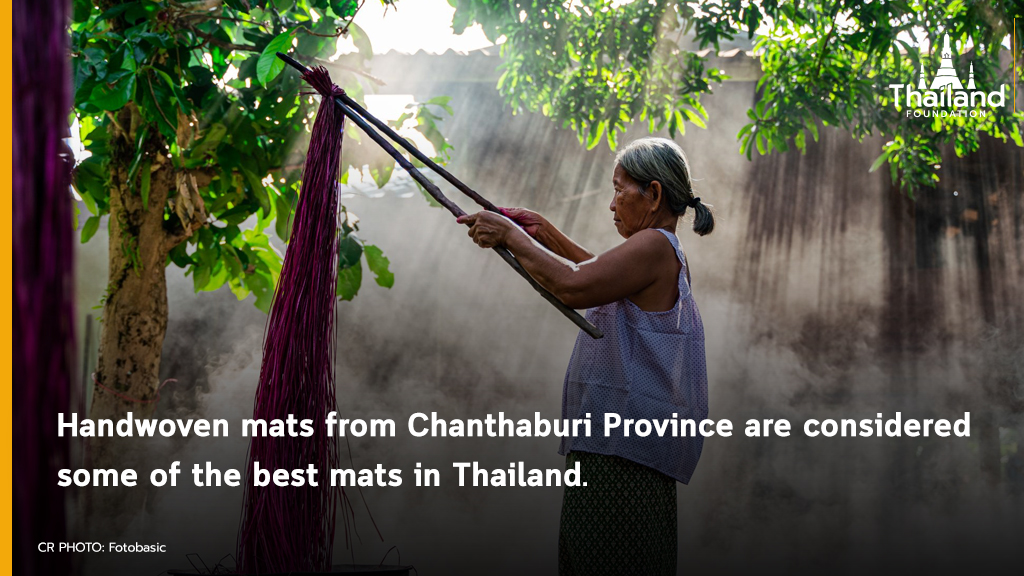
The Chathaboon handwoven mats, or suea Chantaboon [เสื่อจันทบูร], are born out of the skills and innovativeness of local craftsmen. The mats are renowned as some of the best handwoven mats in Thailand, and is considered an icon of Chanthaburi province. Along with their intricate beauty comes a story of cultural harmony and resilience.
What are Chanthaboon mats?
Chanthaboon mats are a type of handwoven mats produced in Chantaburi province in Eastern Thailand. The word “Chantaboon” is an abbreviation of the name Chantaburi. The mats made from This is one reason why the Chantaboon mats are considered one of the best handwoven mats in Thailand. The other reason is the mats’ beauty, which comes from their vivid colors and detailed patterns. Mat weavers from Chanthaburi are able to separate sedge strands into very fine threads. This allowed for them to create more intricate patterns on their mats.
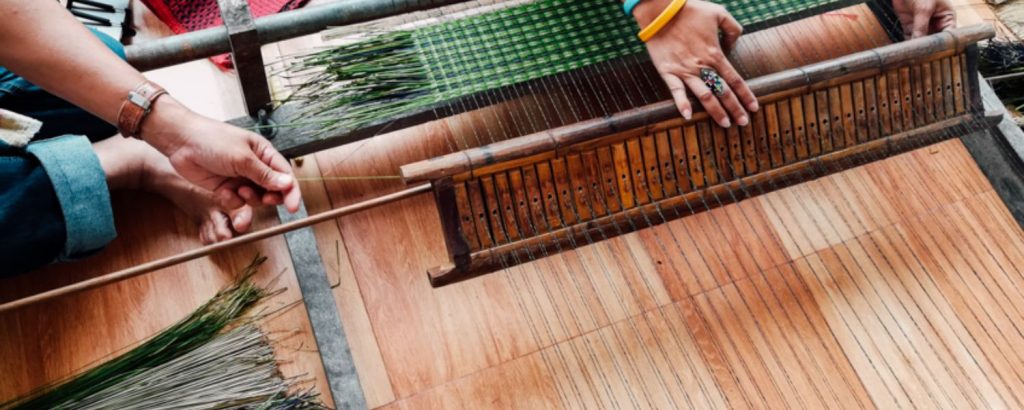
(Photo Credit: ระบบฐานข้อมูลท้องถิ่นจังหวัดจันทบุรี RBRU e-Culture )
History
Chantaboon mats originated from a group of Vietnamese Catholic nuns at the Cathedral of Immaculate Conception in Chanthaburi province. These nuns immigrated to Thailand and were welcomed by the locals, with Catholic and Buddhist communities living side-by-side. The nuns were the first ones to weave mats from local sedge. People called this first generation of mats “suea chee” [เสื่อชี], which means “nun mats”. Locals would grow the plants and deliver them to the nuns, who would weave them into mats. Later on, the nuns would teach the locals how weave the mats.
In 1949, Queen Rambai Barni, the consort of the late King Prajadhipok (Rama VII), returned to Thailand after years of living in the United Kingdom. Now back home, one of her residences was Baan Suan Kaew Palace in Chanthaburi province. The Queen encountered the mats while living here and became captured by their beauty and quality. In the year 1950, Her Majesty set off on a mission to improve the Chanthaboon mat industry. Her Majesty inspected how the nuns were manufacturing the mats and proposed that the sedge strands should be bleached white and colored. A mat factory was erected out of Her Majesty’s initiative. The mats produced at this factory were dubbed “suea Chantaboon somdej” [เสื่อจันทบูรสมเด็จ] or the “Queen’s Chathaboon mats”. Moreover, the mats were made into many different items such as handbags, placemats, and tissue boxes. Queen Rambai Barni also presented the mats under the brand of “utsahagum chaobaan” [อุตสาหกรรมชาวบ้าน] or “folk industry” resulting in the craft becoming a valuable venture until this day. Through Queen Rambai’s efforts, Chanthaboon mats grew in popularity, fueling production as well as shingle flatsedge farming.
![]()
Queen Rambai Barni
(Photo Credit: ระบบฐานข้อมูลท้องถิ่นจังหวัดจันทบุรี RBRU e-Culture )
How are they made?
People in Chanthaburi and nearby provinces would harvest sedges and cut them into small thin sections, gut out the middle, then let them set in the sun to dry for 3-5 days. The sedge will curl up, unveiling its silky smooth interior. After that, they will be dyed and sundried again until they are finally ready to be used for weaving.
The sedge strands are woven on a small loom set up on the floor. Different colored stands are arranged to form patterns. The length of weaving time depends on the intricacy of the designs. After the weaving process is completed, the mats are trimmed around the edges and inspected once more for quality.
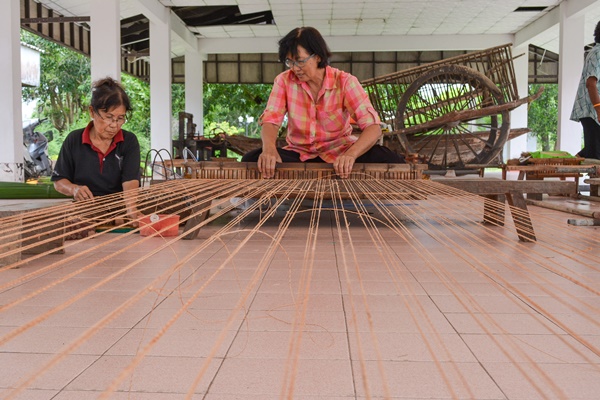
(Photo Credit: True ID )
Types of Chanthaboon mats.
There are many types of Chanthaboon mats, depending on their color and weaving methods. There are three weaving styles:
- Suea shan diew [เสื่อชั้นเดียว], or “one-layer mats”, usually one or two alternating colors. The mats are dense and large in size.
- Suea song chan [เสื่อสองชั้น], or “two-layers mats” contain alternating colors, often with small square patterns in the middle. The strands are not as tightly packed, making them less dense than suea chan diew.
- Seua yok dok [เสื่อยกดอก] can start out as a suea chan diew or a suea song chan. The difference is in the patterns, which is intricate and can made into shapes flowers, geometric designs, or even letters upon the request of the buyers. These mats are difficult to weave and take long hours to produce. The sedge strands used need to be smaller than the ones used in the other two mats.
The mats can also be categorized based on their colors:
- Suea khao [เสื่อขาว], or “white mats”, are made with the whole, triangular sedge strands, with the pattern as dense as the suea song chan. They are very popular in the Northeastern provinces such as Chaiyaphum and Khon Kaen. This type of mat is less expensive in price.
- Suea see [เสื่อสี], or “colored mats” are made with round sedge strands that have been processed by sun drying and coloring. They are popular in Chathaburi, Rayong, Trat and many other provinces.
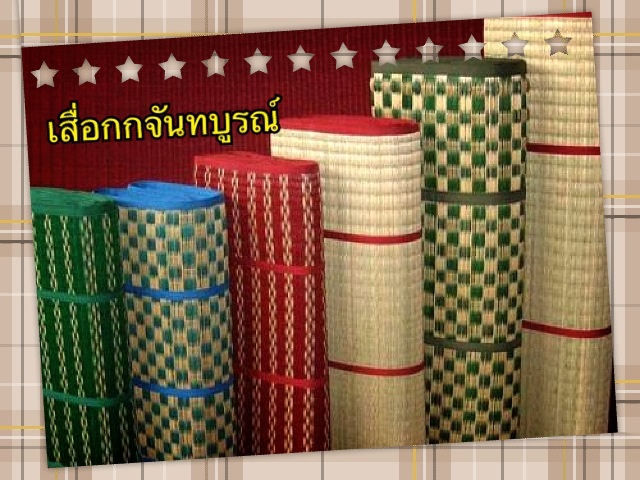
(Photo Credit: โครงการ D-HOPE กรมการพัฒนาชุมชน กระทรวงมหาดไทย )
Chathaboon Mats Today
Chanthaboon mats reflect many qualities of Thai people. First, the origin of the mats reflect a story of openness often found across all regions of Thailand. It shows that Thai people are accepting of different cultures, with different ethnic and religious groups living together in peace. The Thais are also open toward intergrating different traditions and crafts into their own culture. Secondly, the mats mirrors their delicate hands and souls of Thai craftsmen, who are able to turn a mundane house item into intricate works of art. They also reflect a deep respect for nature, which allows craftsmen to understand and resourcefully employ a normal local plant to produce extraordinary craftworks.
Today, Chanthaboon mats are sadly considered a dying craft, however, efforts are made to keep the art alive. The mats are made into many different designs and products such as handbags, briefcases, tissue boxes, placemats and other items. This reflects the creativity and innovativeness of local craftsmen who are determined to carry on the legacy of Chantaboon mats.
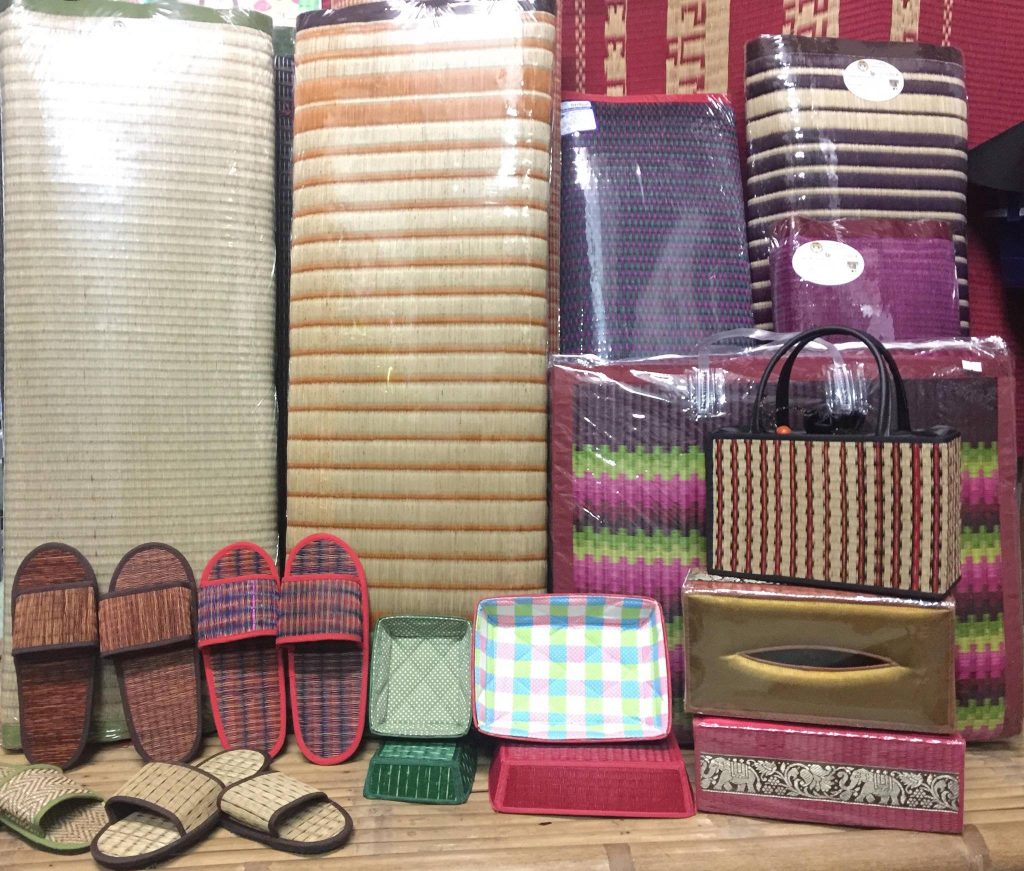
(Photo Credit: ร้านเสื่อจันทบูรณ์)
Sources
- https://www.youtube.com/watch?v=3ao9PGVOWQk
- https://www.m-culture.go.th/chanthaburi/ewt_news.php?nid=935&filename=index
- http://www.arts.rbru.ac.th/art_old/indextp.php?pg=chan/chan_pro.php&tp=t_chan.png
- https://www.youtube.com/watch?v=6xfYNJC109E
______________________________________________________________________________
Author: Worada Elstow
6 September 2022


